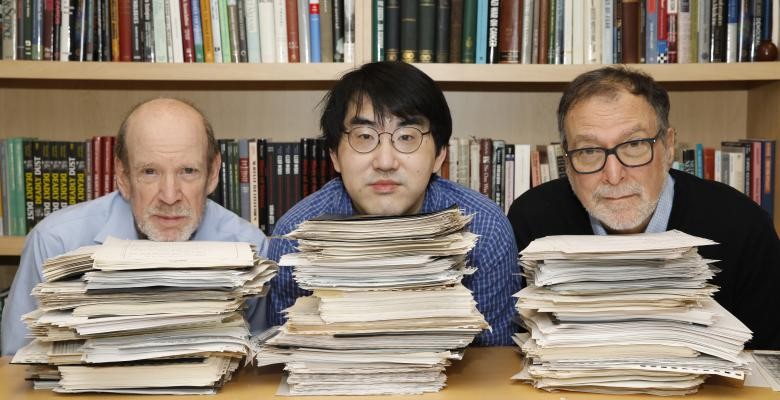ToxicDocs Levels the Playing Field for Efforts to Prevent Toxic Exposures

Johnson & Johnson, the world’s largest health care products maker, is in the midst of more than 10,000 lawsuits claiming that its iconic baby powder is linked to cancer. In July, a verdict by a Missouri jury awarded 22 women $4.6 billion in a lawsuit against the company, supporting their claim that talcum powder caused their ovarian cancer. The case is under appeal.
At issue in that litigation, as in many other cases, is whether the talc-based powder contains asbestos, a known carcinogen, and if the company was aware of the alleged cancer risk for decades and sought to suppress evidence rather than warn consumers.
Now, a powerful resource at Columbia University has opened areas of inquiry about the corporate and regulatory histories of these companies. ToxicDocs is a database of some 20 million once-secret industry and trade association documents concerning the health hazards of toxic chemicals, such as asbestos, lead and polychlorinated biphenyls (PCBs.)
“This material provides a peek into the government agencies responsible for regulating toxic chemicals and the inner workings of major firms that manufactured and sold toxic substances and the products containing them,” said David Rosner, the Ronald H. Lauterstein Professor of Sociomedical Sciences at Columbia Mailman School of Public Health and a professor in the Department of History. “It is the right of the public to know which industries knowingly profited from public health hazards.”
ToxicDocs officially launched in February 2018, and is free and open to all. Its collection consists of discovery documents from myriad lawsuits that were made public once they were introduced in court but were extremely hard for the general public to access. The data includes internal memos, unpublished scientific studies, planning reports for public relations campaigns, meeting minutes and presentations—some dating back to the 1920s—related to the introduction of new products and chemicals into workplaces and commerce. The companies represented in the database range from a small brake manufacturer to multinational giants like J&J and Monsanto.
The three-person ToxicDocs team consists of Rosner; Gerald Markowitz, Distinguished Professor of History at John Jay College and the Graduate Center, City University of New York; and Merlin Chowkwanyun, the Donald H. Gemson Assistant Professor of Sociomedical Sciences at Mailman, who spearheaded the effort to index and digitize the materials. Rosner and Markowitz began collaborating in the 1980s, have written books about occupational and environmental disease and testified as expert witnesses in dozens of cases on behalf of plaintiffs exposed to industrial toxins. They have spent decades accumulating boxes and boxes of company records.
“We had access to millions of documents uncovered in litigation over toxic chemicals, but they were impossible to sift through,” said Rosner, who co-directs the Center for the History and Ethics of Public Health at Mailman, which maintains ToxicDocs with Columbia’s history department and CUNY.
As a Columbia undergraduate more than a decade ago, Chowkwanyun suggested to Rosner posting the material online. “Why not load all those documents for the world to see, and let the public decide for themselves?” he said.
So he spearheaded the building of a website to digitize primary source documents and develop a searchable archive. Seed funding came from Columbia and grants from Amazon and the Robert Wood Johnson Foundation.
“ToxicDocs gives consumers, journalists, scientists, researchers, lawyers, policymakers and community activists a strong, evidence-based tool for raising questions about industrial firms’ behavior,” said Chowkwanyun, whose research centers on the history of community health, racial inequality and social movements. The archive also guards against conspiracy theories that claim that government or industry is purposely poisoning the population, he added.
With a recent $500,000 grant from the National Science Foundation, Chowkwanyun is now in the midst of building a software update that will enhance navigation and provide users with tools to extract patterns in the data. The funding came through Columbia's Data Science Institute, where Chowkwanyun and Rosner are members.
Rosner, an expert witness for the plaintiffs in the Missouri trial, testified that J&J was aware that the FDA and other agencies were concerned about the risks associated with talc-based powder. But, he said, the company “ignored, denied and sought to counter the science that indicated danger.”
He and Markowitz were also expert witnesses in the recent landmark decision on childhood lead poisoning in California, where paint manufacturers were ordered to pay $400 million to the cities of Los Angeles, San Diego, Oakland, San Francisco and a number of counties to remove lead from older homes to stem an epidemic that has afflicted millions of children for decades. In October, the U.S. Supreme Court declined to hear the case, effectively upholding the decision.
“ToxicDocs is one step toward leveling the playing field for efforts to combat toxic exposure,” Rosner said. “Our hope is that as researchers, journalists and the public begin to plumb this digital data we will be better able to understand and counteract the impact of a century of industrialism on our environment and the world.”